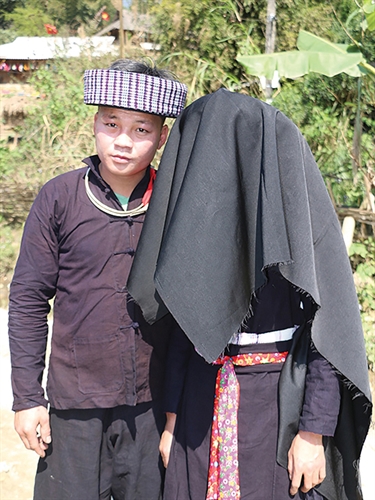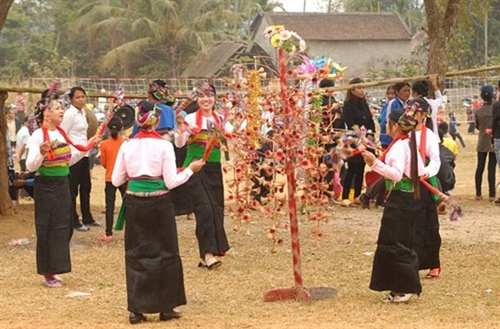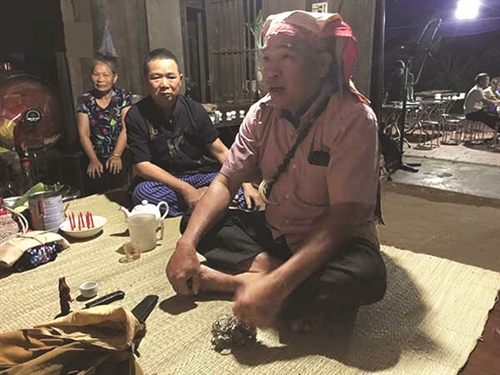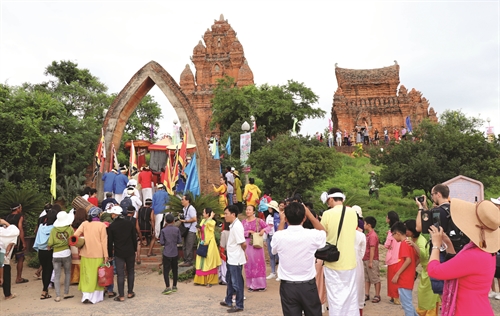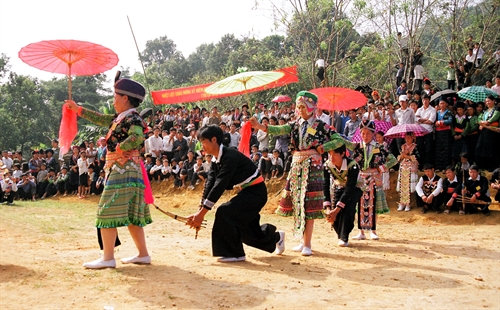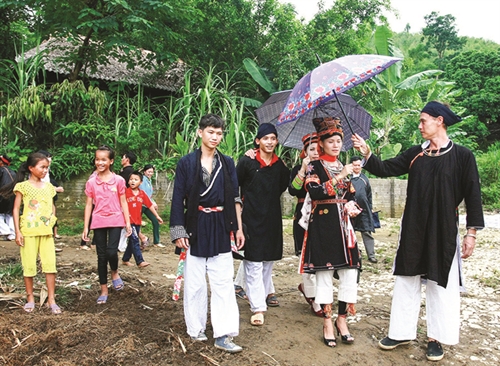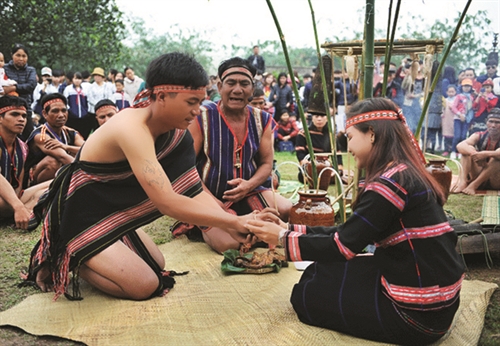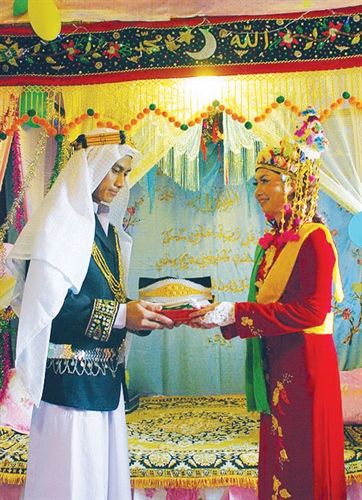Ta Thi Tam, M.A.
Institute of Anthropology
Vietnam Academy of Social Sciences
The Lo Lo, a Tibeto-Burmese language group, is also called O Man, Lu Loc Man, La La, Qua La, Di Nhan, Di Gia or Lac To. The group’s official name Lo Lo has been used in Vietnam since 1979. The Lo Lo group is divided into two sub-groups, namely Lo Lo Hoa and Lo Hoa Den. Today, almost all Lo Lo people reside in upland districts of Ha Giang, Cao Bang and Lai Chau border provinces.
Anthropologists believe that ancestors of Lo Lo people in Vietnam were Di people in Yunnan province of China. Researches on Lo Lo people in the country often cite a note in Dai Viet Su ki toan thu (Complete Annals of Dai Viet) which read “In Mau Thin (the Year of the Dragon-1508), Lo Lo people in Yunnan overflowed into Thuy Vi area of Hung Hoa town.” It seemed that after migrating to Vietnam, the Lo Lo settled down in the areas which are now Dong Van district of Ha Giang province and Bao Lac district of Cao Bang province. The Lo Lo were considered the first people presenting in these far-off areas and that’s the reason why other ethnic groups such as the Hmong, Dao, Nung, Giay, Co Lao, Pu Peo and Tay all worship Lo Lo ancestors to pay respect to those who were credited with having reclaimed the borderland.
To adapt to natural conditions, the Lo Lo grew maize and rice on mountain slopes and developed terraced rice fields. Lo Lo people used to determine planting schedules by using a special calendar which differs from all the others - a 11-month calendar without February and with 11 zodiac animals. The tiger came first, followed by the bee, snake, bear, horse, goat, monkey, chicken, dog, pig and lastly, rat.
In a Lo Lo house, the ancestor altar is erected close to the wattle of middle compartment, the most solemn part of the house. The wattle is inserted with wooden or bamboo dummies representing the house owner’s great grandparents, grandparents and parents. Meanwhile, the souls of their great great grandparents are invited to stay at the entrance door and therefore hitting the entrance door with a knife is a taboo for Lo Lo people. Right underneath the altar or in the left compartment of the house is another altar for family members who drop dead. To the Lo Lo, this is the most sacred place of a family where only the family master is allowed to come and do the cleaning. Lo Lo people make offerings to their ancestors on the lunar New Year festival and mid-July festival, on special occasions such as wedding, childbirth, and funeral, or when they wish to pray for blessings and favors from their ancestors.
The Lo Lo also worship three Gods, called Ma do, Ma qua and Ma me, who live in the Holy Forest and are believed to be the creators of mountains, land, water. On the 12th day of the third lunar month, every Lo Lo village holds a ritual, called mi lu, in the Holy forest, to pay tribute to these Gods. Every family in the village has to contribute money to buy offerings and sends a member to join the ritual. Representatives of families in the village will take turn to perform the role of hosting the ritual. In the day of the ritual, no one is allowed to enter the village while villagers may neither go to the field nor do such jobs as husking and pounding rice. Those who break the taboo will have to pay compensation. After the ritual finishes, the man who chairs the ritual will be the first person in the village to sow seeds.
There are three important events in the life of Lo Lo people: birth, marriage and death. When a baby is born, he will be cleaned with a new cloth and his umbilical cord will be cut with a small bamboo bark, tied with a thread and put into a bamboo cylinder which is hidden in the forests. Three days after childbirth, both the newborn and his mother are bathed in water which has been earlier boiled with scent leaves such as pomelo and guava leaves. Lo Lo people usually fix a bunch of green leaves at the staircase leading to the house to inform visitors of the childbirth and warn them off as the delivery is believed to be spiritually dirty.
In the past, Lo Lo women used to give birth at home. The place where the mother gives birth must be far from the family’s fire stove. During the delivery, the mother-to-be is helped by a midwife and her mother-in-law while no man, not even her husband, may come in. After the child is born, both the mother and her newborn will be taken to stay near the stove for about two weeks and then moved into her chamber. Nowadays, almost all Lo Lo women give birth at medical stations. However, after the mother and the baby return home, the family must invite a shaman to hold a ritual to receive back the souls of both mother and newborn. During the postpartum confinement, which lasts for 33 days from the day of childbirth, the mother is not allowed to use the village’s shared-use water pipeline system but catch water from a separate pipe.
When the postpartum confinement period ends, the family invites a shaman to hold a naming ceremony for the baby. The most important offering at the ceremony is tui pui, a votive house made of leaves devoted to Ba mu, the goddess believed to give shape to and protect the baby. As soon as the ritual finishes, tui pui will be hung on the pillar of the house’s porch and kept there until the baby reaches full 15 years.
Lo Lo people follow monogamy mechanism and couples live with the grooms’ families. A Lo Lo boy is considered a grown-up and ready to get married when he knows how to worship and pray for Gods and ancestors. Marriages used to be arranged by parents but young people are now free to choose their soulmates. When a man finds the woman he loves, he will ask his parents to send matchmakers to the girl’s family to make the proposal. The Lo Lo has a special wedding tradition that wedding presents will not be brought to the bride’s home but handed over to the girl’s uncle who will later transfer them to the bride’s parents.
A wedding party of Lo Lo people often lasts for several days, starting from the time when the groom and his companions arrive at the bride’s home and ending after the uncle and other relatives of the bride who accompany her to her new family set off home.
It is the Lo Lo’s traditional customs that the groom’s parents must hide somewhere when the bride enters the groom’s house as Lo Lo people believe that the bride will get sick after marriage if she meets face-to-face with her parents-in-law at that moment. After the wedding party, the newlyweds will visit to the bride’s family and stay there for a few days and then return to the groom’s home.
According to the Lo Lo’s belief, a human being has the body and the soul. When a person dies, the soul of the dead still exists, wandering in the world of the living and disturbing the children’s life until the dead body is buried.
At present, the Lo Lo is the only ethnic group that plays bronze drums at funerals. Lo Lo people believe that without the sound of bronze drums, the dead will not be accepted by his ancestors and that the sound of bronze drums is the only means of communications with the other world which will pave the way for the dead’s soul to his forefathers.-
